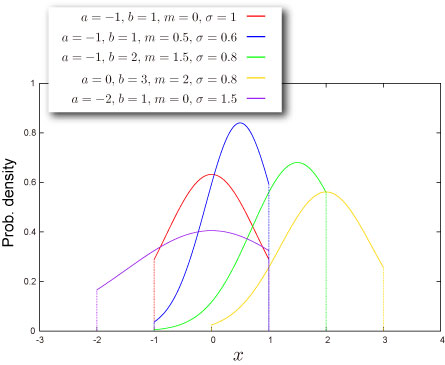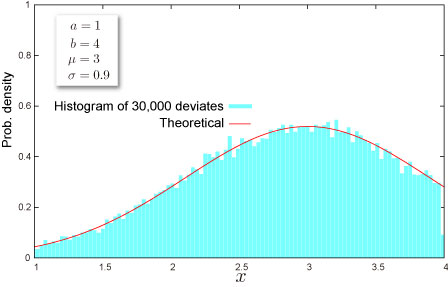Truncated normal distribution
Where will you meet this distribution?
- Econometrics : probit model, tobit model
- Marketing
“Use of the Left-Truncated Normal Distribution for Improving Achieved Service Levels” by Arvid C. Johnson
- Agriculte
Shape of Distribution
Basic Properties
- Four parameters
are required (How can you get these).
- Continuous distribution defined on bounded range
- This distribution can be symmetric or asymmetric.
Probability
- Cumulative distribution function
where
and
is cumulative distribution function of standard normal distribution.
- Probability density function
- How to compute these on Excel.
1 2
3 4 5 6 7 8
9
A B Data Description 2.5 Value for which you want the distribution 1 Value of parameter Min 4 Value of parameter Max 3 Value of parameter M 0.9 Value of parameter Sigma Formula Description (Result) =NTTRUNCNORMDIST(A2,A3,A4,A5,A6,TRUE) Cumulative distribution function for the terms above =NTTRUNCNORMDIST(A2,A3,A4,A5,A6,FALSE) Probability density function for the terms above 
- Function reference : NTTRUNCNORMDIST
Quantile
- Inverse of cumulative distribution function
where
and
is cumulative distribution function of standard normal distribution.
- How to compute this on Excel.
1 2
3 4 5 6 7 8
A B Data Description 0.5 Probability associated with the truncated normal distribution 1 Value of parameter Min 4 Value of parameter Max 3 Value of parameter M 0.9 Value of parameter Sigma Formula Description (Result) =NTTRUNCNORMINV(A2,A3,A4,A5,A6) Inverse of the cumulative distribution function for the terms above - Function reference : NTTRUNCNORMINV
Characteristics
Mean – Where is the “center” of the distribution? (Definition)
- Mean of the distribution is given as
where
,
and
are probability density function and cumulative distribution function of standard normal distribution respectively.
- How to compute this on Excel
1 2 3 4 5 6 7 A B Data Description 1 Value of parameter Min 4 Value of parameter Max 3 Value of parameter M 0.9 Value of parameter Sigma Formula Description (Result) =NTTRUNCNORMMEAN(A2,A3,A4,A5) Mean of the distribution for the terms above - Function reference : NTTRUNCNORMMEAN
Standard Deviation – How wide does the distribution spread? (Definition)
- Variance of the distribution is given as
where
,
and
are probability density function and cumulative distribution function of standard normal distribution respectively.
Standard Deviation is a positive square root of Variance.
- How to compute this on Excel
1 2 3 4 5 6 7
A B Data Description 1 Value of parameter Min 4 Value of parameter Max 3 Value of parameter M 0.9 Value of parameter Sigma Formula Description (Result) =NTTRUNCNORMSTDEV(A2,A3,A4,A5) Standard deviation of the distribution for the terms above - Function reference : NTTRUNCNORMSTDEV
Skewness – Which side is the distribution distorted into? (Definition)
- Skewness of the distribution is given as
where
,
and
are probability density function and cumulative distribution function of standard normal distribution respectively.
- How to compute this on Excel
1 2 3 4 5 6 7
A B Data Description 1 Value of parameter Min 4 Value of parameter Max 3 Value of parameter M 0.9 Value of parameter Sigma Formula Description (Result) =NTTRUNCNORMSKEW(A2,A3,A4,A5) Skewness of the distribution for the terms above - Function reference : NTTRUNCNORMSKEW
Kurtosis – Sharp or Dull, consequently Fat Tail or Thin Tail (Definition)
- Kurtosis of the distribution is given as
where
,
and
are probability density function and cumulative distribution function of standard normal distribution respectively.
- How to compute this on Excel
1 2 3 4 5 6 7 A B Data Description 1 Value of parameter Min 4 Value of parameter Max 3 Value of parameter M 0.9 Value of parameter Sigma Formula Description (Result) =NTLOGNORMKURT(A2,A3,A4,A5) Kurtosis of the distribution for the terms above - Function reference : NTTRUNCNORMKURT
Random Numbers
- Random number x is generated by inverse function method, which is for uniform random U,
where
,
and
are probability density function and cumulative distribution function of standard normal distribution respectively.
- How to generate random numbers on Excel.
1 2 3 4 5 6 7 A B Data Description 1 lower limit of support 4 upper limit of support 3 Value of parameter M 0.9 Value of parameter Sigma Formula Description (Result) =NTRANDTRUNCNORM(100,A2,A3,A4,A5,0) 100 truncated normal deviates based on Mersenne-Twister algorithm for which the parameters above Note The formula in the example must be entered as an array formula. After copying the example to a blank worksheet, select the range A7:A106 starting with the formula cell. Press F2, and then press CTRL+SHIFT+ENTER.

NtRand Functions
- If you already have parameters of the distribution
- Generating random numbers based on Mersenne Twister algorithm: NTRANDTRUNCNORM
- Computing probability : NTTRUNCNORMDIST
- Computing quantile : NTTRUNCNORMINV
- Computing mean : NTTRUNCNORMMEAN
- Computing standard deviation : NTTRUNCNORMSTDEV
- Computing skewness : NTTRUNCNORMSKEW
- Computing kurtosis : NTTRUNCNORMKURT
- Computing moments above at once : NTTRUNCNORMMOM
- If you know mean and standard deviation of the distribution
- Estimating parameters of the distribution:NTTRUNCNORMPARAM

 RSS
RSS
